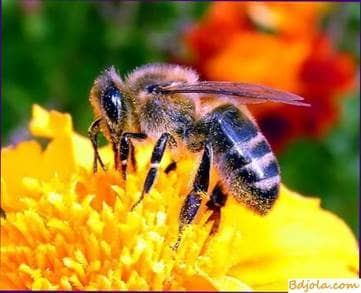Bee Species Used in Greenhouses

In our country the following species of bees have become most widespread: Central Russian, Ukrainian steppe, gray mountain Caucasian, yellow Caucasian and Carpathian and their varieties.
In the greenhouses can work and preserve all the domestic bee breeds. However, each breed of bees has its advantages and disadvantages, which should be taken into account.
The most common in the world are the Central Russian bees. In Western Europe, they are known as dark forest and European bees.
Central Russian bees are the largest in comparison with bees of other breeds, they have short proboscis and well developed wax glands, due to which they build up many honeycombs. Bees are evil, when you look at the nest from the smoke run down the honeycomb. This property they developed as a reaction to self-preservation from fires in the forest. Central Russian bees are adapted to harsh living conditions during prolonged winters. They are rolylivy, productive with good late medosbora. The honeycomb has a pleasant white color.
In our country, a variation of the Central Russian bee is the Bashkir, Ural, mountain-taiga and Altai bees.
The valuable quality of Central Russian bees when using them in greenhouses is their “flower constancy”, ie, the attachment of bees to the collection of pollen and nectar from a certain plant species. Even with the appearance of the best medon, the Central Russian bees continue to visit the former honey plant for a long time. This property of bees is very important in the cultivation of greenhouse cucumbers, as the latter are mediocre medonosomes. Unfortunately, the rumors and the sordidness of the Central Russian bees restrain their widespread use in greenhouses.
Gray mountain Caucasian bees are very peaceful and able to fly for honey at a lower air temperature, even when drizzling rain, so valuable for pollination of cucumbers in greenhouses,
Gray mountain Caucasian bees due to the long length of the proboscis (7-7.2 mm) are the best pollinators of the meadow clover. They are non-vigorous, energetic in the search for sources of honey, and with a weak allocation of nectar, plants are more productive than Central Russian bees. Along with this, the gray mountain Caucasian bees have significant shortcomings. They hibernate badly during prolonged winters, are prone to nosematosis, develop poorly in the spring, weakly build up honeycombs, and have an unsightly wet honeycomb. In greenhouse farms, where the wintering time of bees is significantly reduced, these disadvantages could be tolerated, but their positive qualities – the rapid search for the best honey and the rapid switching to it are highly undesirable when using bees in greenhouses. With the advent of the best medon, gray mountain Caucasian bees leave the worst,
In the 60-ies. A great success in hothouse facilities enjoyed the Krajina bees. They are mountain bees, distributed mainly in Yugoslavia and Austria. In many ways, the edges are close to the gray mountain Caucasian bees, but they are slightly inferior to them along the length of the proboscis. They have a gray coloration of the body with silvering of the 2-5th abutment of the abdomen.
Like the gray mountain Caucasian bees, the krainki fly behind the honey at lower temperatures and cloudy weather. They are enterprising in the search for flowering plants, they are productive, they build a honeycomb well, they have a white honeycomb.
Krajina bees stop brood rearing in early autumn, and spring develop rapidly, which makes it possible to consider the Krajina bees as the most economical and productive ones. Early termination of brood rearing is especially important in the control of varroa.
In the last decade, the edges have been replaced by bees of the Carpathian rock.
Carpathian bees have all the positive qualities of the margins, but unlike them are weakly prone. Carpathian bees work in greenhouses flawlessly, have high viability, they have a well developed sense of orientation, compared to bees of other breeds, they are less inclined to wander, and this is important when keeping bees, especially in block greenhouses.
According to our observations, the Krajina and Carpathian bees are hostile to bees of other breeds. This should be borne in mind when reinforcing bee colonies, organizing cuttings and other works.
Of the large number of domestic and foreign breeds of bees, it is of interest to use Italian bees in greenhouses.
In our country, Italian bees were imported from abroad periodically. By the prevalence in the world, they occupy the second place after the Central Russian bees. Characterized by the yellow coloration of the dorsal half-rings of the abdomen, they differ in peacefulness and weak rylivism. They have a high productivity with good late honey production. In the spring development, Italian bees lag behind bees of other breeds, and in the autumn they continue to grow brood for a long time, as a result, 18-20 kg of honey left in the nests for the winter are consumed to a considerable extent, therefore, its replenishment is required.
Italian bees have a weak winter hardiness, but in greenhouse farms, where bees are exhibited in January and February, one could tolerate this, but their significant drawback is increased voracity.
In this respect, they are incomparable with other breeds of bees. From what has been said, it can be seen that among domestic and imported bees there is no ideal breed.
In our country, preference is given to the breeding of Carpathian bees. However, it should be noted that nurseries supplying apiaries with Carpathian umbels often expel not purebred, but metizirovannyh queens. Pure breeds of Carpathian queens can only be obtained from the Mukachevo bee-nursery of the Uzhgorod region.
Bee Species Used in Greenhouses
